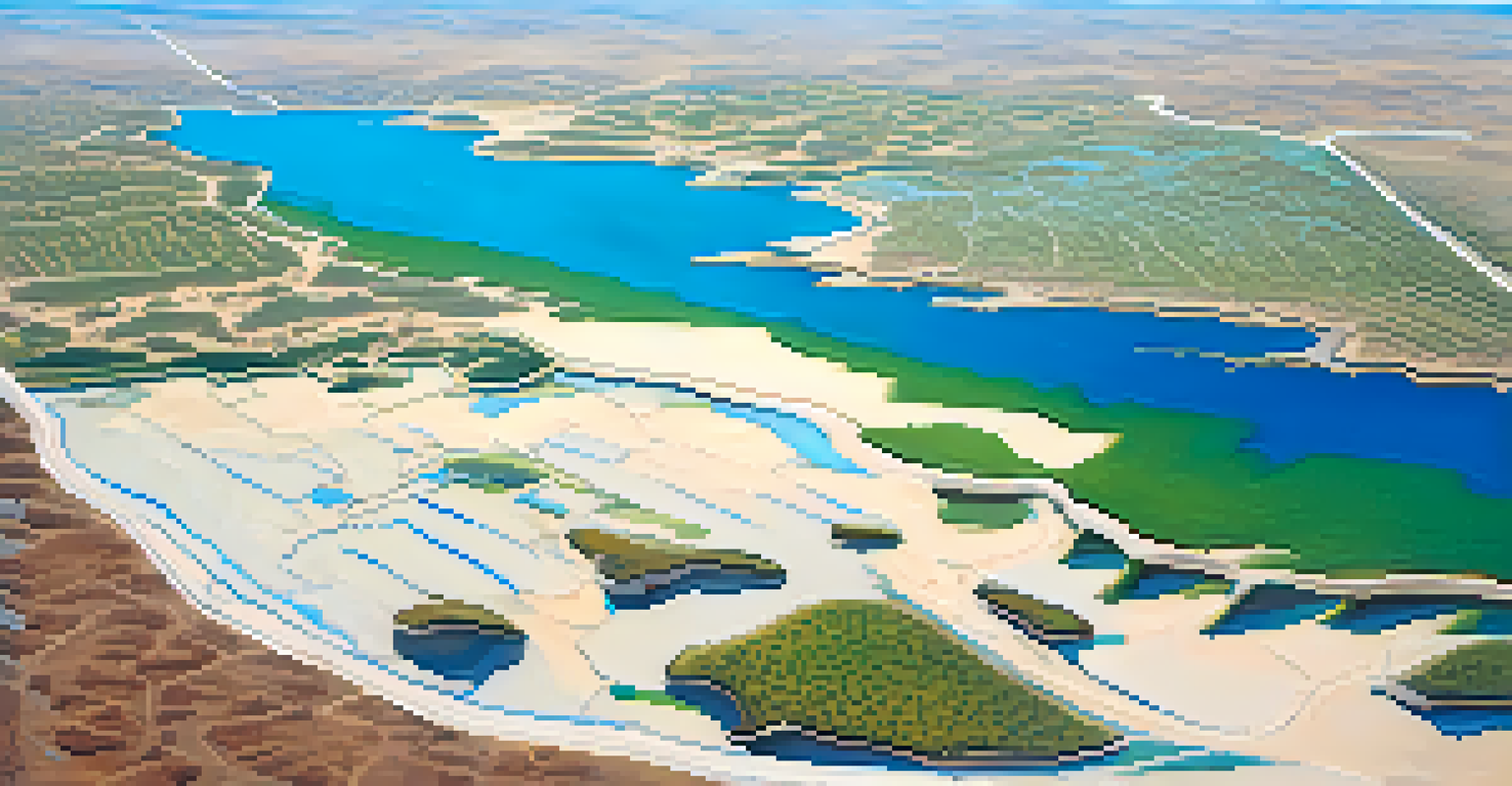Drought Cycles: Impact on California's Water Resource Management

Understanding Drought Cycles in California
Drought cycles refer to the recurring periods of below-average precipitation that California often experiences. These cycles can vary in length and severity, significantly impacting water availability across the state. For instance, the recent multi-year droughts have highlighted how vulnerable California's water resources are to climate fluctuations.
Water is the most precious resource we have. It’s vital for life, for agriculture, and for our economy.
Droughts in California aren't a new phenomenon; they've been documented for centuries. However, the increasing frequency and intensity of these cycles in recent years raise concerns about how sustainable current water management practices are. As these droughts become more common, understanding their patterns becomes crucial for effective planning.
By studying past droughts, we can identify trends that inform future resource management. For example, recognizing that severe droughts are often followed by periods of heavy rainfall can help water managers plan better for both extremes. This understanding is key to developing strategies that ensure water availability even during the driest years.
The Economic Impact of Drought Cycles
Drought cycles have a significant economic impact, particularly in a state like California where agriculture is a major industry. Reduced water supply can lead to lower crop yields, affecting farmers' incomes and the overall economy. For instance, during the last major drought, the agricultural sector faced billions in losses, which rippled through local communities.

In addition to agriculture, other sectors such as tourism and recreation also feel the pinch during droughts. Water shortages can limit recreational activities like boating and fishing, which are vital to California's tourist appeal. This can lead to a decrease in tourist spending, further straining the economy.
Drought Cycles Impact Water Supply
California's recurring drought cycles significantly affect water availability, highlighting the need for sustainable management practices.
Moreover, the economic ramifications of droughts extend to increased water costs and infrastructure needs. As water becomes scarcer, cities may have to invest in more expensive alternatives, such as desalination plants, to meet demand. This can lead to higher utility bills for residents and businesses alike.
Environmental Consequences of Droughts
Drought cycles can have devastating effects on California's natural ecosystems. Many plant and animal species rely on consistent water supply for survival, and prolonged drought conditions can lead to habitat degradation. For example, reduced water levels in rivers can threaten fish populations, disrupting the entire aquatic ecosystem.
The greatest challenge of the 21st century is to provide clean water to a growing population while protecting our environment.
Additionally, droughts can exacerbate issues like wildfires, which have become increasingly common in California. Dry conditions create a perfect environment for fires to ignite and spread, leading to loss of wildlife habitat and increased carbon emissions. This not only impacts biodiversity but also contributes to climate change.
As ecosystems struggle to adapt to changing water availability, the long-term consequences can be severe. The loss of native species, for instance, can disrupt food chains and reduce resilience against future environmental stressors. This highlights the importance of integrating ecological considerations into water management strategies.
Water Resource Management Strategies
Effective water resource management is essential for navigating drought cycles in California. One strategy involves investing in water conservation technologies, such as smart irrigation systems that optimize water use in agriculture. By using less water, farmers can maintain their crops while also safeguarding the resource for future generations.
Another approach is to enhance water storage capabilities through the construction of reservoirs and groundwater recharge projects. These initiatives can help capture and store excess water during wet years, ensuring that it’s available during droughts. For instance, recharging groundwater aquifers can provide a buffer against future water shortages.
Economic Consequences of Droughts
The economic impact of droughts extends beyond agriculture, affecting tourism and increasing water-related costs for residents.
Moreover, promoting policies that encourage sustainable water use among residents is vital. Educational campaigns can raise awareness about water conservation practices at home, such as fixing leaks and using drought-resistant landscaping. These collective efforts can significantly reduce overall water demand, making management more effective.
The Role of Technology in Water Management
Technology plays a pivotal role in modern water resource management, especially in the face of drought cycles. Innovations like satellite imagery and remote sensing can help monitor water levels and soil moisture across vast areas. This data is invaluable for making informed decisions about water allocation and conservation efforts.
Additionally, smart water meters are becoming increasingly common in urban areas, providing real-time data on water usage. This allows consumers to track their usage and adjust habits accordingly, reducing waste. By integrating technology into everyday water management, both individuals and municipalities can contribute to more sustainable practices.
Furthermore, predictive analytics can aid in forecasting drought conditions, allowing for proactive measures to be taken. By analyzing weather patterns and historical data, water managers can better anticipate shortages and plan accordingly. This forward-thinking approach is crucial for building resilience against future drought cycles.
Community Engagement in Water Conservation
Community engagement is vital for effective water conservation efforts, especially during drought cycles. Local organizations and governments can work together to promote awareness about the importance of saving water. For example, community workshops can educate residents about practical ways to reduce water consumption at home.
Involving the community in decision-making processes also fosters a sense of ownership and responsibility. When residents participate in discussions about water management, they are more likely to commit to conservation efforts. This can lead to innovative solutions that reflect the unique needs and values of each community.
Community Engagement is Essential
Involving communities in water conservation efforts fosters a culture of responsibility and encourages innovative solutions.
Moreover, grassroots initiatives, such as neighborhood challenges to reduce water use, can create a culture of conservation. Friendly competitions can motivate residents to adopt water-saving habits, making conservation a community priority. When everyone works together, the impact can be profound.
Future Outlook: Adapting to Drought Cycles
As climate change continues to alter precipitation patterns, adapting to drought cycles will be crucial for California's future. Water resource management strategies must evolve to incorporate more flexible and resilient practices. This may include revising water rights and regulations to respond more effectively to changing conditions.
Moreover, investing in research and development for innovative water-saving technologies will be essential. The future may hold breakthroughs in water recycling methods or more efficient agricultural practices that help mitigate the effects of drought. By prioritizing innovation, California can lead the way in sustainable water management.

Lastly, fostering collaboration between state agencies, local governments, and communities will be critical. A unified approach can help ensure that all stakeholders have a voice in shaping water policies. Together, they can work towards a sustainable future, even in the face of inevitable drought cycles.